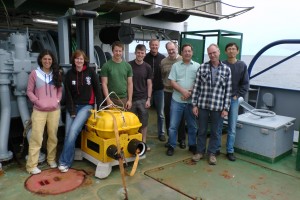Gaye Bayrakci, Tim Minshull, Jon Bull and Richard Davy from the G&G group, with colleagues from six other institutions, have published a paper in Nature Geoscience this week, entitled “Fault-controlled hydration of the upper mantle during continental rifting”. This paper is the first to document a direct link between the fault activity and the amount of water entering the solid Earth along the faults.
At specific temperature and pressure conditions, the reaction between mantle peridotite and seawater results in changes in physical properties and forms a rock called serpentinite. Serpentinised mantle rocks are found beneath the seafloor at slow- to ultraslow-spreading mid-ocean ridges and are thought to be present at about half the world’s rifted margins. They are also inferred to be present in the downgoing plate at the subduction zones. The formation of serpentinite requires a supply of fluid to the mantle. The crustal rocks have low permeabilities and the fault zones with higher permeabilities are believed to play an important role in the migration of fluids to the mantle depths.
This paper shows that the serpentinisation at the rifted continental margin offshore western Spain was probably initiated when the whole crust cooled to become brittle, and the deformation was focused along crust cutting normal faults. Using seismic waves to map the distribution of serpentinite below the hyper-extended crust of the Galicia margin, the authors show that the amount of the serpentinite formed at the bottom of each fault was directly proportional to the displacement on that fault, which in turn is closely related to the duration of the fault activity.
In other settings, and possibly also during continental breakup, the focused flow of seawater along faults provides a setting for exotic life-forms that live off the chemicals stripped out of the rocks by the water as it flows into and then out of the Earth’s mantle. The researchers were also able to estimate the average rate at which seawater entered the mantle through the faults, and discovered that rates are comparable to those estimated for water circulation in hot rock at mid-ocean ridges, where such life-forms are more common.

